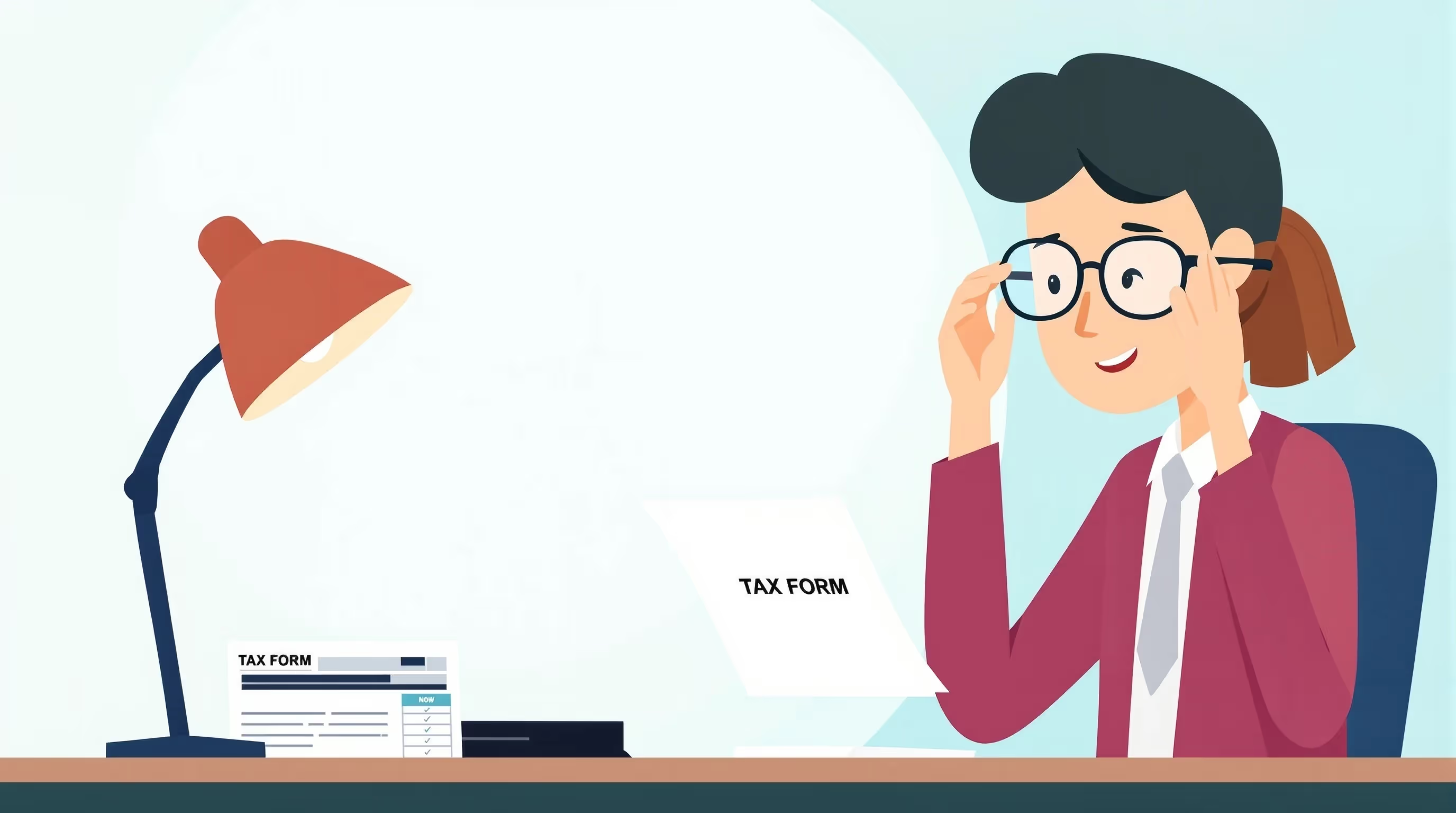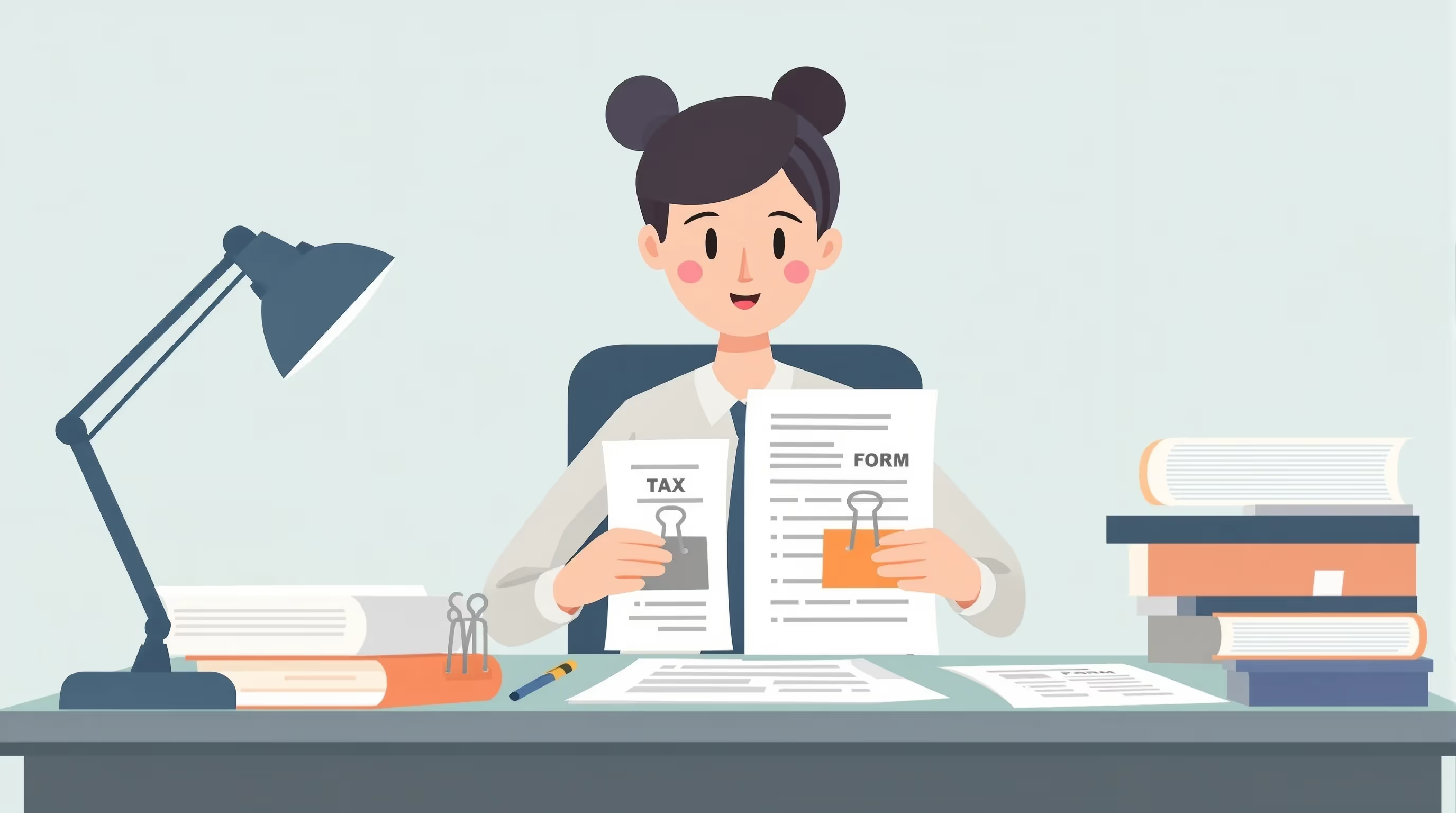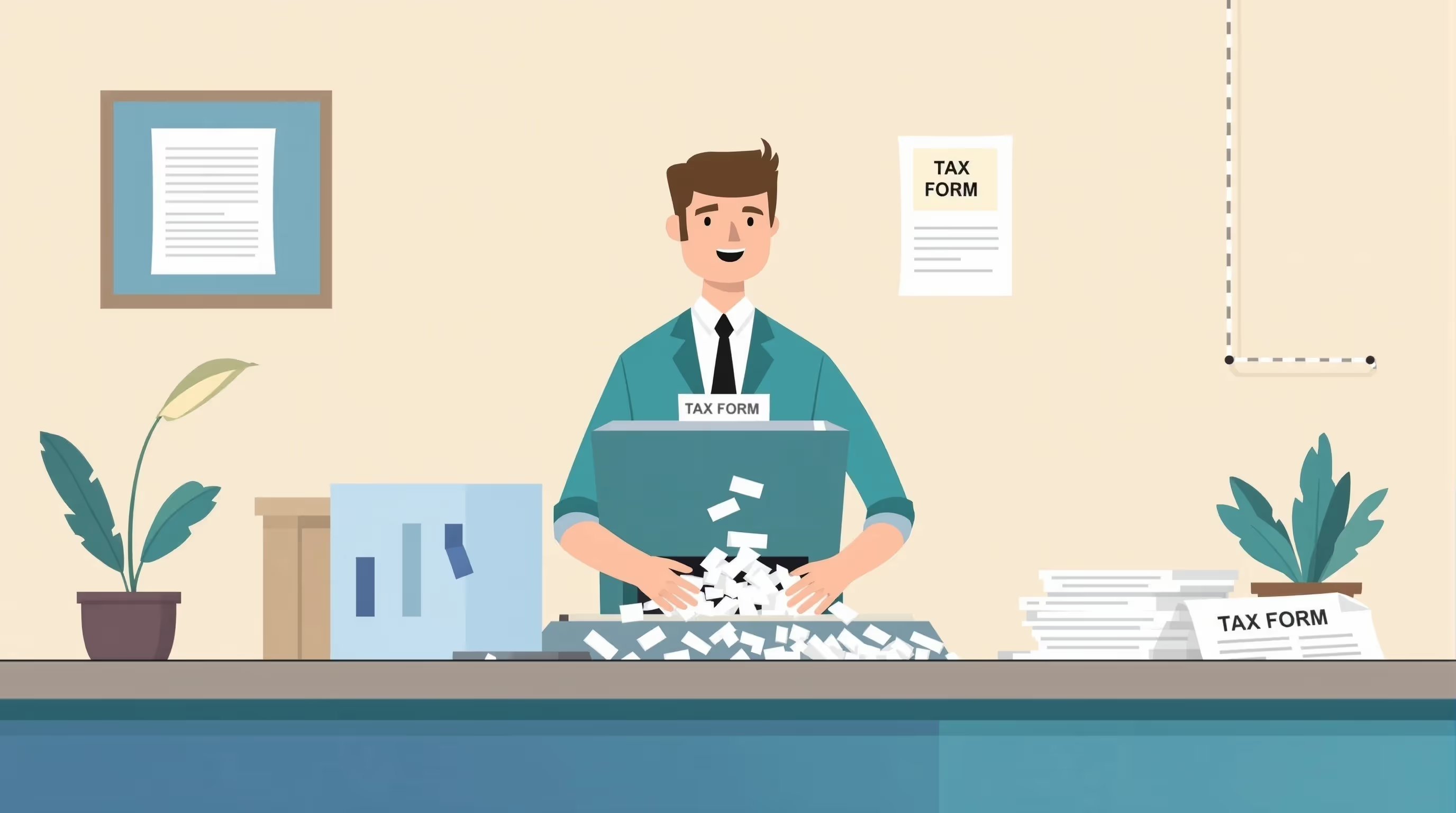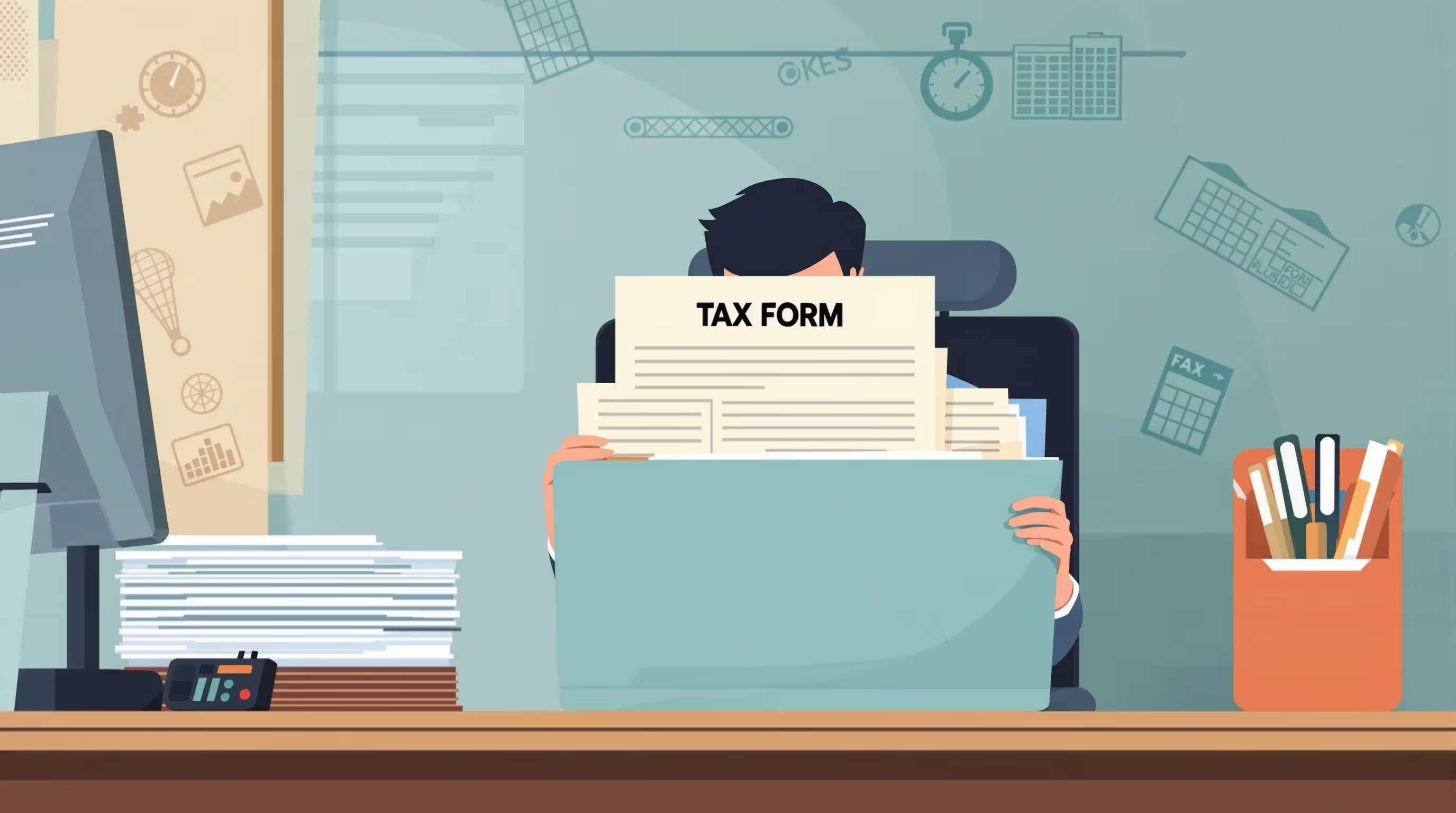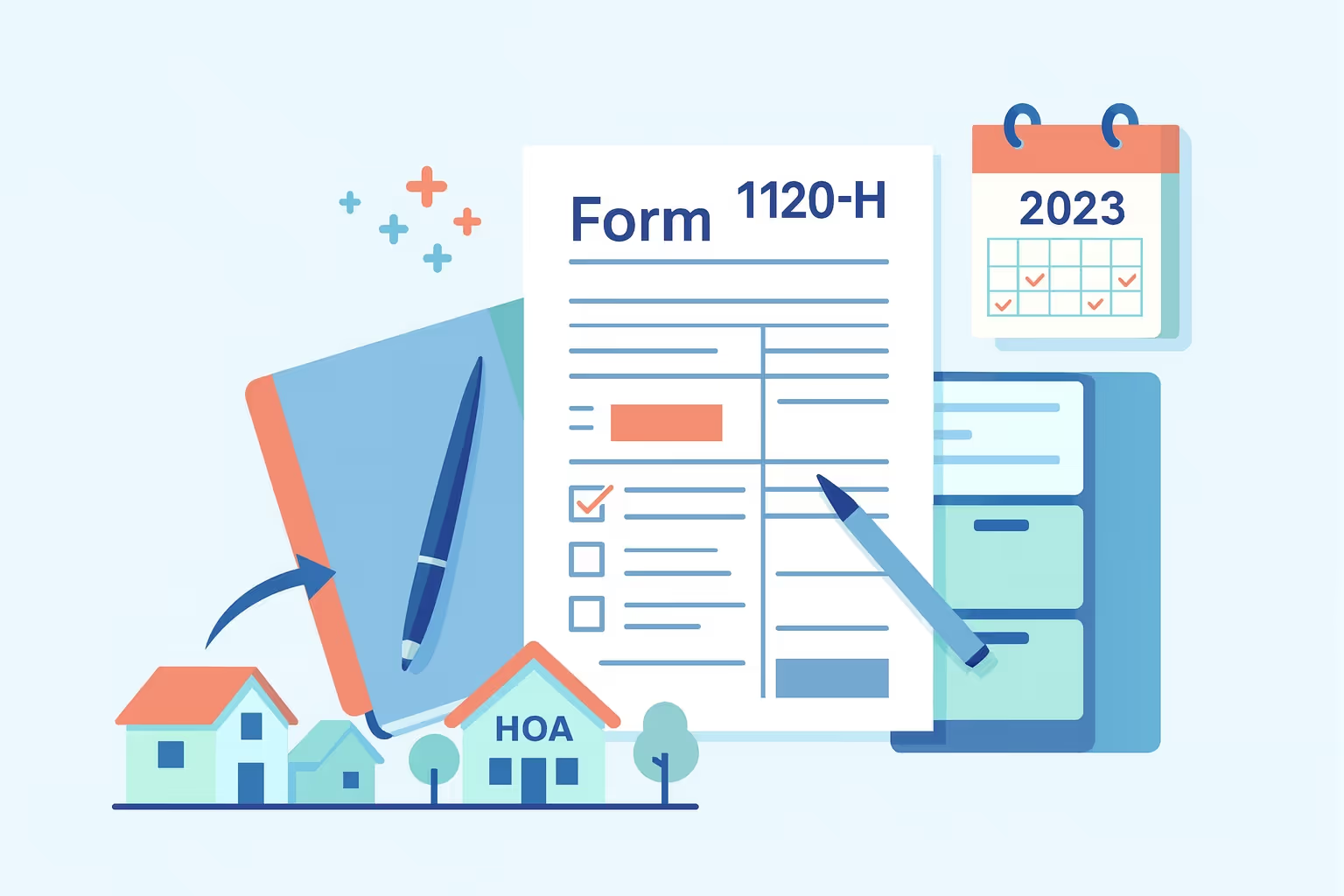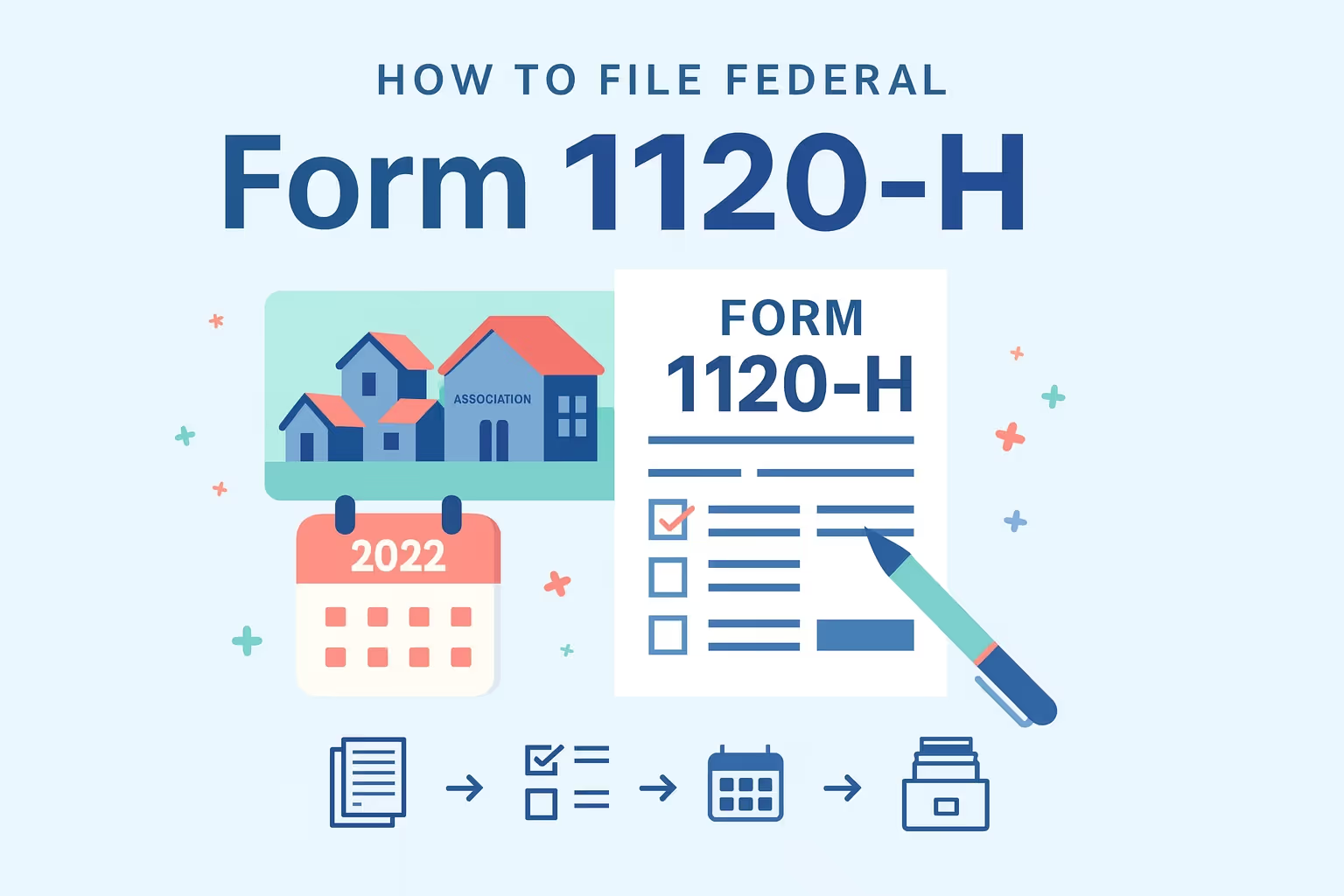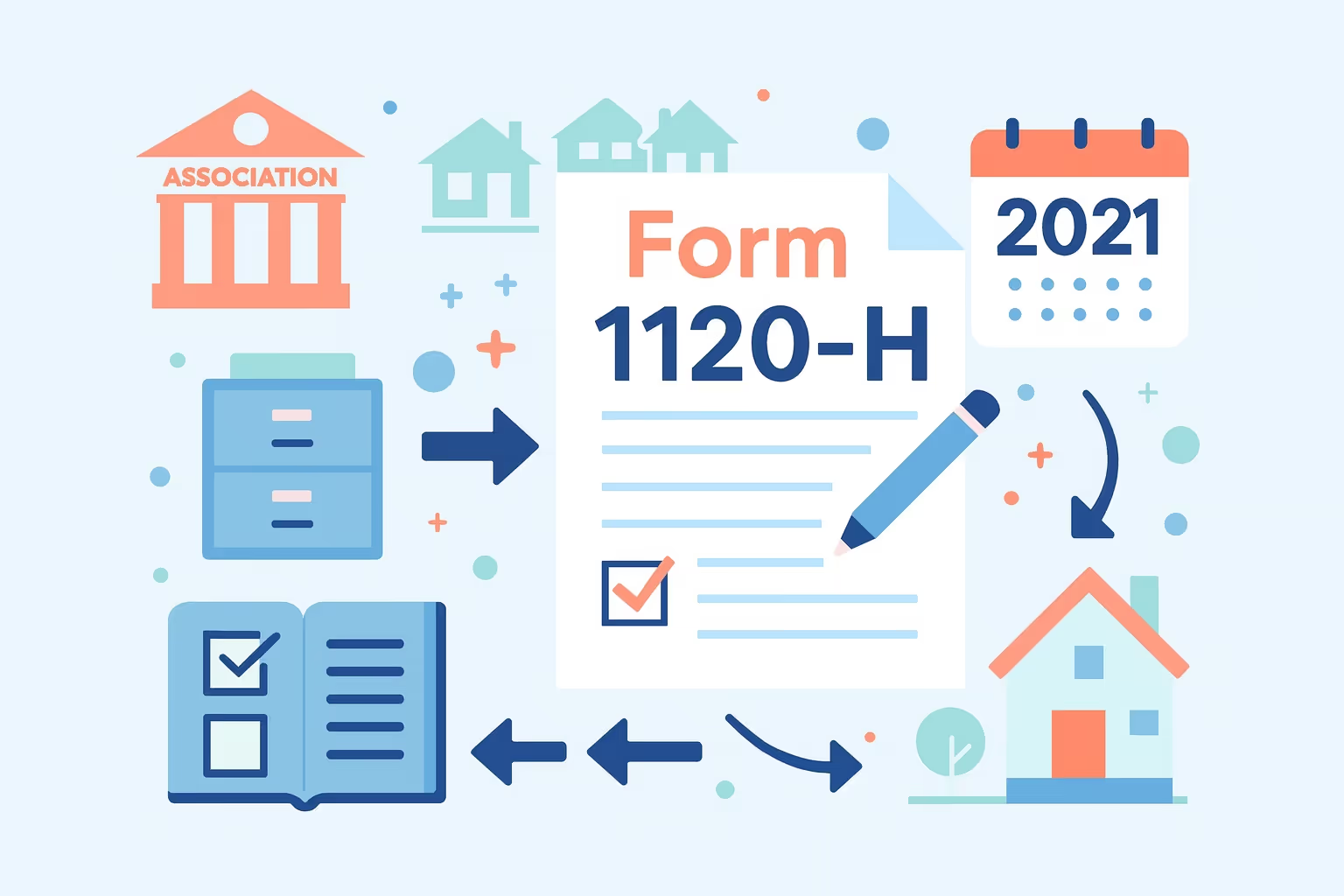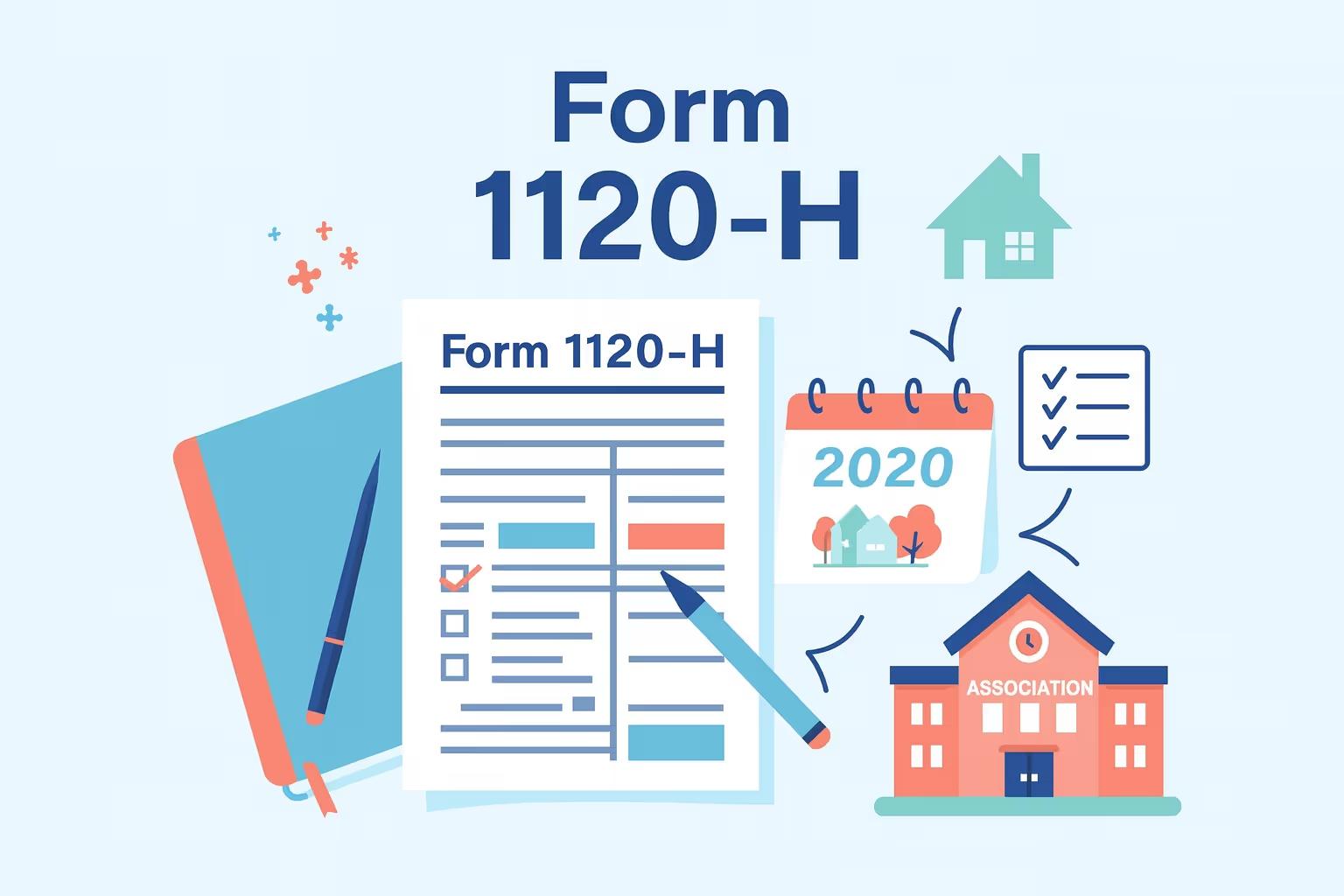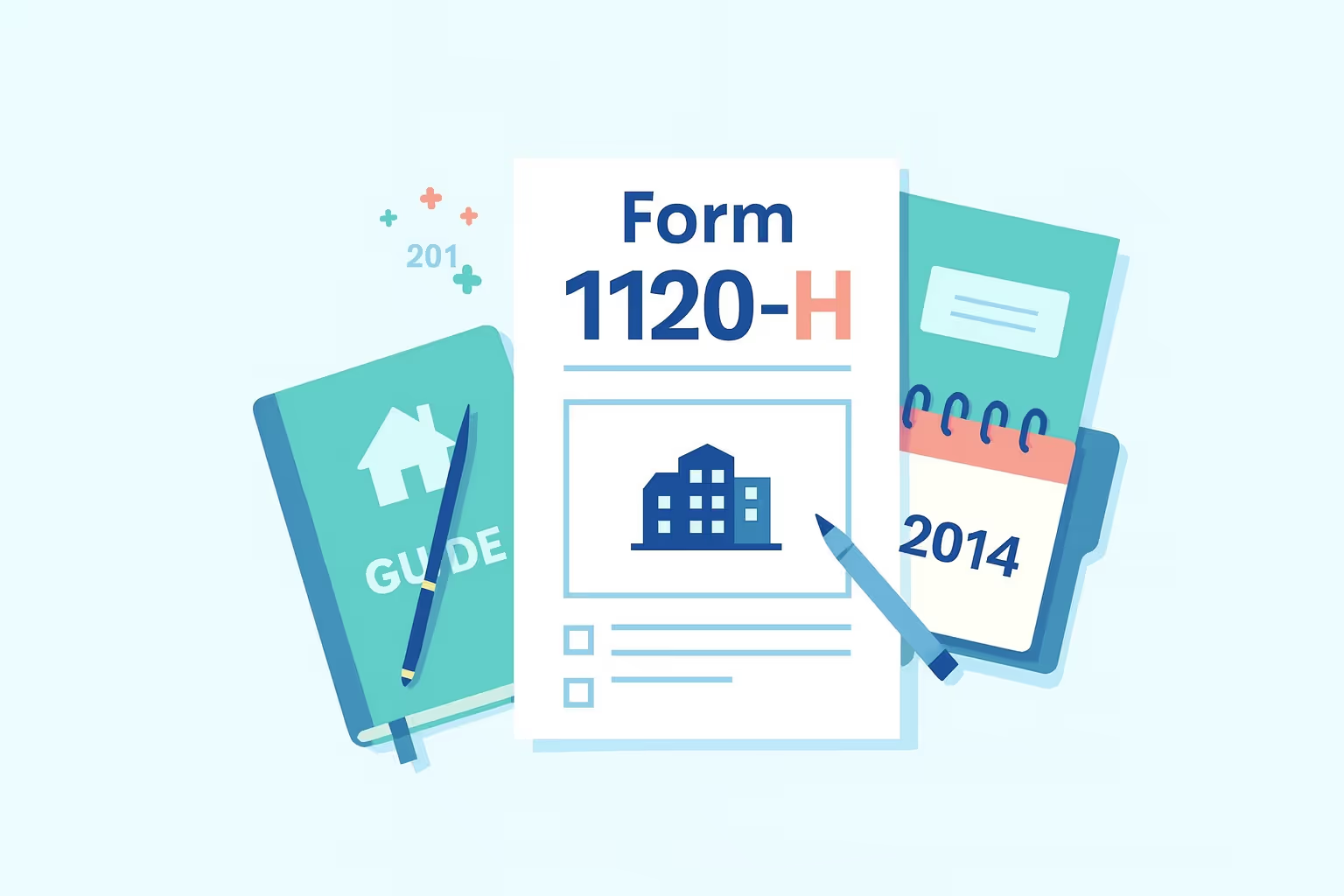How to File Federal Form 1120-H for Tax Year 2024 (HOAS)

Thousands of homeowner associations face penalties annually because of mistakes or delays in their tax filings. The IRS now imposes a minimum late-filing penalty of $510 if an association misses its deadline by more than 60 days. Beyond the financial hit, a late or incorrect filing can cost your association the ability to exclude exempt function income, one of the most valuable tax benefits available under the Internal Revenue Code.
Federal Form 1120-H for Tax Year 2024 for HOAs is not just another piece of paperwork. The specialized income tax return allows residential real estate associations, condominium management associations, and timeshare associations to simplify reporting and reduce tax liability. When filed correctly, it lets associations exclude exempt function income from taxable income, claim a flat tax rate, and avoid unnecessary complications. Filing incorrectly or missing the deadline can turn those benefits into costly burdens.
This guide will walk your association through everything needed to file Form 1120-H accurately for tax year 2024. We will explain how to prepare financial records, calculate taxable income, apply deductions, and choose between paper and electronic filing. Along the way, you will see why early preparation and attention to detail are crucial to protect your association’s finances and maintain compliance with the IRS.
Understanding Federal Form 1120-H for Tax Year 2024 for HOAs
Form 1120-H is the corporation income tax return explicitly created for homeowners' associations under section 528 of the Internal Revenue Code. It allows these organizations to take advantage of certain tax benefits that reduce their tax burden and simplify compliance. Associations may exclude exempt function income instead of treating all revenue as taxable. Exempt function income consists of membership dues, assessments, and fees collected from homeowners for maintaining association property.
Without this form, a homeowners association must file a standard corporate return (Form 1120). That return is more complex and often results in higher taxes because it does not automatically exclude exempt function income. By filing Form 1120-H, an association streamlines reporting while protecting its ability to claim essential tax benefits. The Internal Revenue Service recognizes this to reduce administrative burden while ensuring that funds collected for community services are not taxed as regular corporate earnings.
Who Qualifies to File Form 1120-H?
Not every organization can use Form 1120-H. To qualify, a homeowners association must meet all four IRS tests:
- Association Type Test: The organization must be one of three types: a condominium management association, a residential real estate association, or a timeshare association. These categories cover the most common homeowner-managed communities and ensure that the tax form applies to residential properties rather than commercial ones.
- 60% Gross Income Test: At least 60% of the association’s gross income must come from exempt function income. This means most funding must come from membership fees, dues, or assessments rather than outside business activities such as facility rentals or investment returns.
- 90% Expenditure Test: At least 90% of the association’s total expenditures must be for acquiring, building, managing, maintaining, or caring for association property. This includes costs for landscaping, security, real estate taxes, pool maintenance, or repairs on shared property.
- No Private Benefit Rule: Net income cannot be used to benefit individuals. The only exception is if excess membership dues are returned to homeowners as rebates or credits, which is permitted.
If a homeowners association fails even one of these requirements, it cannot file Form 1120-H for that tax year. In that case, the organization must file a standard corporation income tax return instead.
Key Tax Benefits of Filing Form 1120-H
Filing Federal Form 1120-H for Tax Year 2024 for HOAs provides several advantages that reduce taxes owed and filing complexity. The most important benefits include:
- Flat Rate Tax: Most associations pay a 30% tax rate on taxable income, while timeshare associations pay 32%. This flat rate simplifies calculations and avoids the complications of progressive corporate tax brackets.
- Exclusion of Exempt Function Income: Membership fees, dues, and assessments are excluded from taxable income. This prevents double taxation on funds collected to maintain the community.
- $100 Specific Deduction: All associations filing Form 1120-H automatically deduct $100 from taxable income. While small, this deduction still lowers total tax liability.
- Simplified Filing Process: Compared with Form 1120, Form 1120-H requires fewer schedules and less detailed reporting. This saves time and lowers the risk of errors.
Comparison of Form 1120-H vs Form 1120
Form 1120-H (Homeowners’ Associations)
- Tax Rate: Flat 30% (32% for timeshare associations).
- Exempt Function Income: Excluded from taxable income.
- Specific Deduction: Automatic $100 deduction allowed.
- Filing Complexity: Simplified return with fewer schedules required.
- Eligibility: Only available for homeowners’ associations.
Form 1120 (Corporations)
- Tax Rate: 21% corporate rate, which may result in higher taxes compared to Form 1120-H.
- Exempt Function Income: Fully taxable under corporate rules.
- Specific Deduction: No automatic deduction.
- Filing Complexity: More complex; requires detailed schedules and reporting.
- Eligibility: Applies to all other corporations not eligible to file Form 1120-H.
This illustrates why filing Form 1120-H is often the better choice for HOAs. While the flat tax rate may be higher than the corporate tax rate, the ability to exclude exempt function income usually results in lower overall tax liability.
What’s New in Tax Year 2024
Tax law changes can directly impact how homeowners' associations file their returns. For the 2024 tax year, the Internal Revenue Service has introduced updates that affect filing methods, penalties, and payment rules. Understanding these changes will help associations avoid mistakes and unnecessary penalties when filing Federal Form 1120-H for Tax Year 2024 for HOAs.
Electronic Filing Now Available
For the first time, associations can file Form 1120-H electronically. This option becomes available starting January 2025 for 2024 returns. E-filing offers several advantages: faster processing, confirmation of receipt, and fewer errors due to built-in validation systems. Associations that file 10 or more returns in a year—including employment tax and information returns—are required to file electronically. A waiver can be requested, but only under limited circumstances.
Updated Penalties and Deadlines
The IRS increased the minimum penalty for late returns filed more than 60 days past the due date. The penalty is now less than the total tax due, or $510. This change underscores the importance of filing on time. Even if your association owes no tax, filing late can still result in this penalty. Associations should also ensure estimated tax payments are made by the original due date because extensions apply only to filing, not payment.
Reminders on Federal Tax Payment Rules
Homeowners' associations must submit all federal taxes electronically through the Electronic Federal Tax Payment System (EFTPS). The IRS no longer accepts paper checks mailed with tax forms. Submitting payment through EFTPS provides scheduling options and proof of payment, which helps avoid disputes. Failing to use EFTPS can cause delays, interest charges, or penalties for unpaid taxes.
Step-by-Step Guide to Filing
Filing Federal Form 1120-H for Tax Year 2024 for HOAs requires careful preparation. Errors can cause delays, penalties, or even loss of the ability to exclude exempt function income. The following steps break down the process so your association can comply with IRS requirements.
Preparation Checklist
Before completing the form, gather all critical documents. Missing or incomplete records are among the top reasons for delayed returns.
- Employer Identification Number (EIN): Every association must have an EIN. If your association does not yet have one, you must apply on the IRS website. Once received, keep your EIN confirmation letter in permanent files because you will use it every year.
- Financial Records: Collect all bank statements, investment records, and receipts for the 2024 tax year. These documents are essential to accurately reporting gross income and deductions. Organizing them in advance prevents errors and makes the filing process more efficient.
- Prior Tax Return: Keep last year’s filing while preparing the new return. Reviewing the preceding year’s return helps ensure consistency across filings and can reduce the risk of discrepancies.
- Tax-Exempt Interest Received: If the association earned tax-exempt interest, such as dividends from municipal bonds or mutual funds, it must be reported. Even small amounts are considered reportable income.
- Any Forms 1099: Review all 1099 forms received for the year. These may reflect taxable interest income, contractor payments, or other sources that the IRS expects to see reported.
Completing this checklist ensures that your homeowners association files accurately and reduces the chance of unpaid tax or reportable transaction understatements.
Completing the Form Section by Section
Form 1120-H has several key parts. Associations must provide correct information in each section.
- Header Information: Enter the association’s legal name, mailing address, and EIN exactly as they appear in your governing documents. Also, include the date of formation to maintain accurate records with the IRS.
- Qualification Tests: Fill out items A through D with care. This section requires confirmation that at least 60% of gross receipts come from exempt function income, at least 90% of expenditures are related to association property, and that no private individual benefits from net income.
- Gross Income: Report only non-exempt income such as interest, capital gains, rental payments from non-members, or guest fees. Remember that exempt function income consists of membership fees, dues, and assessments, which must be excluded from taxable income.
- Deductions: Report expenses only if they are directly tied to taxable income. Examples include bank fees on taxable accounts or repairs to income-generating facilities. Do not include costs funded by exempt function income, since they do not qualify as deductible.
- Tax Liability Calculation: Deductible deductions from taxable income and apply the $100 specific deduction. Multiply the remaining amount by the flat tax rate, which is 30% for most associations and 32% for timeshare associations.
Calculating Taxable Income and Tax Liability
A practical example makes the process more transparent. Suppose an association has $8,000 in non-exempt income from interest and rentals. If it claims $2,000 in deductions tied directly to those earnings, taxable income before the $100 deduction is $6,000. After subtracting the deduction, the taxable income is $5,900. Multiplying this by the 30% flat rate produces a total tax liability of $1,770.
This example shows why excluding exempt function income is crucial. Without that exclusion, taxable income would be far higher, resulting in a much larger tax bill.
Filing Electronically vs Paper Filing
Associations can now choose between electronic and paper filing. While paper filing remains an option for organizations with fewer than 10 total returns, electronic filing provides faster processing, fewer errors, and immediate confirmation.
E-file vs Paper Filing Timelines
E-File
- Refund Timeline: Refunds are typically processed within 30 days.
- Error Correction: Built-in validation systems help prevent common mistakes.
- Filing Confirmation: Associations receive immediate acknowledgment of acceptance.
- Penalty Risk: Lower, since electronic filing reduces errors and ensures deadlines are met more reliably.
Paper Filing
- Refund Timeline: Refunds often take 8 weeks or longer, especially during peak tax season.
- Error Correction: Mistakes may cause rejected filings and significant delays.
- Filing Confirmation: No confirmation is provided until the IRS manually processes the return.
- Penalty Risk: Higher, due to mailing delays and increased risk of filing errors.
Choosing to file forms electronically speeds up the process and reduces the likelihood of unpaid tax caused by errors or delays. The Internal Revenue Service strongly recommends e-filing whenever possible.
Final Steps Before Submission
- Sign and Date: An authorized officer, such as the president, treasurer, or chief accounting officer, must sign the return. If a paid preparer completed the compensation form, they must also sign it.
- Review Attachments: Ensure that all required schedules and supporting statements are attached. For proper identification, each attachment should include the association’s legal name and EIN.
- Check Filing Deadline: The due date is the 15th day of the fourth month after the close of the association’s tax year, which is April 15, 2025, for calendar-year filers. If additional time is needed, file Form 7004 for an extension, but remember that the extension only applies to filing, not payment.
- Submit Payment: Any tax liability must be paid through EFTPS by the original due date—failure to pay on time results in interest charges and penalties, which can accumulate quickly.
By carefully following this checklist, your association’s tax return will be accurate, timely, and compliant with IRS tax law. This reduces the risk of audits, penalties, and the painfully slow refund process resulting from filing errors.
Payments, Credits, and Penalties
Correctly handling payments and credits is just as important as filing the tax return itself. Mistakes in this stage can create unpaid tax balances, trigger penalties, and even jeopardize the ability to file Form 1120-H in future years. Homeowners ' associations must follow the IRS rules carefully to stay compliant.
Payment Rules for HOAs
The IRS requires all federal taxes paid by homeowners' associations to be submitted electronically. Payments must be made through the Electronic Federal Tax Payment System (EFTPS). Mailing checks with your tax return is no longer allowed. EFTPS provides several advantages: it will enable associations to schedule payments in advance, create an electronic record of all federal taxes paid, and offer confirmation numbers for every transaction.
Associations that cannot pay their taxes in full have options. If the balance owed is $25,000 or less, they may request an installment agreement online. This arrangement allows the association to spread payments over 24 months, although interest and penalties will still apply. Setting up the installment agreement online is generally faster than submitting a paper request.
Claiming Tax Credits and Deductions
Associations may be eligible to claim certain tax credits, which reduce total tax liability. Examples include qualified electric vehicle credit, low-income housing credit, and new market credit. To use these credits, an HOA must attach the appropriate IRS forms, such as Form 3800 for general business credits.
In addition to credits, associations can carry forward a net operating loss from prior years. This may reduce taxable income in the current year. However, deductions must be directly connected to producing taxable income. Expenses tied to exempt function income cannot be deducted because they do not reduce taxable income under Form 1120-H rules.
Penalties to Avoid
The IRS imposes strict penalties when associations fail to comply.
- Failure-to-File Penalty: If the homeowners association files late without an extension, the penalty is 5% of the unpaid tax for each month the return is late. This penalty can accumulate up to 25% of the total balance due.
- Failure-to-Pay Penalty: If the association does not pay on time, the penalty is generally 0.5% of the unpaid monthly tax, and the balance remains outstanding. This penalty also continues to grow until the tax is fully paid.
- Substantial Understatement: The IRS may impose an additional penalty if the association significantly underreports taxable income. Understatements in reportable transactions may trigger further scrutiny and higher penalties.
Avoiding these penalties begins with timely filing, paying through EFTPS, and ensuring that all income and deductions are reported accurately. Filing correctly the first time saves the association both time and money.
Common Errors and How to Avoid Them
Even small mistakes can create significant problems when filing Federal Form 1120-H for Tax Year 2024 for HOAs. Errors may result in penalties, delayed refunds, or the loss of certain tax benefits. By understanding the most frequent issues, associations can proactively avoid them.
Filing Status and Eligibility Errors
- Incorrect Association Type: Many associations mistakenly check the wrong box when identifying as a residential real estate association, a condominium management association, or a timeshare association. Selecting the incorrect type can change the tax rate or even invalidate the filing. Always confirm your association type before completing the form.
- Failure to Meet Qualification Tests: Some homeowners' associations file without confirming that they meet the 60% gross income and 90% expenditure tests. If these tests are not met, the association cannot legally use Form 1120-H. Consistently perform and document the calculations before filing.
Income and Deduction Classification Mistakes
- Reporting Exempt Function Income as Taxable: Member dues, assessments, and specific fees are exempt and should be excluded from taxable income. When associations report them in error, they overstate taxable income and pay unnecessary tax. Carefully separate exempt function income from taxable income before completing the form.
- Deducting Non-Qualified Expenses: Some associations attempt to deduct expenses tied to exempt function income, such as landscaping or pool maintenance, funded by dues. These expenses cannot be deducted on Form 1120-H. Only expenses directly tied to producing taxable income are deductible.
Missing Deadlines or Signatures
- Late Filing: Missing the filing deadline results in penalties and the possible loss of the right to file Form 1120-H for that year. Always mark the due date, and use Form 7004 if additional time is needed.
- Unsigned Returns: The IRS rejects returns not signed by an authorized officer, such as the treasurer, president, or chief accounting officer. If a paid preparer completed the form, their signature must also be included.
Reviewing these common errors in advance allows homeowners' associations to file confidently, avoid unnecessary costs, and ensure their tax return is processed promptly.
Special Filing Situations
Not all homeowner's associations operate under the same conditions every year. Some may be newly formed, others may have a year with little or no activity, and others may need to amend a prior return. The Internal Revenue Service provides guidance for these situations, but each requires careful handling to avoid penalties and preserve the ability to file Form 1120-H in future years.
Zero Activity or Dormant Years
An association may experience a year with no income or expenditures, except for minimal items such as bank fees or small interest income. Even in these cases, the homeowners' association must file Federal Form 1120-H for Tax Year 2024 for HOAs. Filing ensures the association maintains its election under section 528 of the Internal Revenue Code. If the association skips filing, it risks losing the right to exclude exempt function income in future years.
When filing for a dormant year, associations should report minimal income, such as interest income, and claim the $100 specific deduction. In most cases, this results in no tax liability. However, failing to file can create problems later, so compliance remains essential.
First-Time Filers
Newly formed associations often face confusion in their first year of filing. First-time filers must confirm their employer identification number is valid and ensure that qualification tests are met. If the association’s gross receipts or total expenditures do not align with IRS requirements, filing Form 1120-H may not be possible. In that case, filing a standard corporation income tax return may be required.
Amendments and Final Returns
If an error is discovered after filing, the association must file an amended return. To do this, the “Amended return” box on Form 1120-H must be checked, and the corrected form must be submitted with explanations for the changes. If an association is dissolving, it must file a “Final return” and indicate that status on the form. Both situations must include complete documentation to avoid additional IRS inquiries.
By addressing these unique cases properly, associations can remain compliant with tax law and avoid unnecessary disputes with the IRS.
Best Practices for Recordkeeping and Compliance
Filing Federal Form 1120-H for Tax Year 2024 for HOAs is only part of the compliance process. Good recordkeeping ensures that the association can support every figure on the return and respond effectively if the Internal Revenue Service audits the filing.
Required Documentation
Every homeowners' association should maintain detailed records of both income and expenses. This includes membership dues, fees, bank statements, and all receipts connected to association property. Expenses such as landscaping, real estate taxes, utilities, and professional service invoices must also be documented. Supporting materials like board meeting minutes, governing documents, and prior tax returns should be organized and accessible.
A consistent filing system reduces the chance of errors. Many associations find it helpful to separate income sources into categories: exempt function income, taxable income, and other receipts. Precise categorization makes it easier to exclude exempt function income and demonstrate compliance with the gross income and expenditure tests.
Retention Periods and IRS Audits
The IRS recommends keeping most tax records for at least three years after filing. However, if an association underreports income by more than 25 percent, the retention period extends to six years. Property records should be kept indefinitely because they affect capital gains calculations when property is sold.
Strong recordkeeping practices also make audits less stressful. Organized files prove that the association followed tax law and calculated taxable income accurately. Consistency year after year demonstrates reliability and lowers the risk of penalties.
FAQs
What happens if a homeowners' association fails to file Form 1120-H?
If a homeowners' association fails to file Form 1120-H, it may lose the ability to claim certain tax benefits for that tax year. The IRS will require the association to file a standard corporation income tax return instead, which can increase taxable income and total tax liability. Late filing also triggers penalties, including a minimum penalty of $510 if more than 60 days overdue.
Can homeowners' associations claim tax-exempt status automatically?
No, homeowner's associations do not receive automatic tax-exempt status. They must meet IRS requirements yearly by filing Federal Form 1120-H for Tax Year 2024 for HOAs and passing the qualification tests. These tests include the 60% gross income and 90% expenditure tests. Filing ensures exempt function income is excluded from taxable income and maintains compliance with the Internal Revenue Code.
How does the IRS handle income tax withheld or federal tax paid in error?
If income tax withheld or federal tax paid was misreported, the association may claim a credit or refund on its tax return. Any overpayment will be applied against the total tax due or refunded, depending on the election made. Associations must document payments carefully and provide proof, such as EFTPS confirmation numbers. In cases of error, filing an amended return may be necessary.
Is a tax professional necessary if the association has only membership fees and no gross income beyond exempt function income?
Even if exempt function income consists only of membership fees, consulting a tax professional may be wise. Filing Form 1120-H seems simple, but errors in reporting accounting methods, deductions, or exempt function income can result in penalties. A tax professional ensures that exempt income is excluded correctly, the filing deadline is met, and the association’s tax year is handled consistently.
What are the due date rules if an HOA changes accounting methods or its association’s tax year?
When an association changes accounting methods or modifies its association’s tax year, special rules apply. Form 1128 may be required to request IRS approval for these changes. The due date for Form 1120-H remains the 15th day of the fourth month after the close of the new tax year, unless an extension is filed. Failure to follow proper procedures may result in unpaid taxes and penalties.






